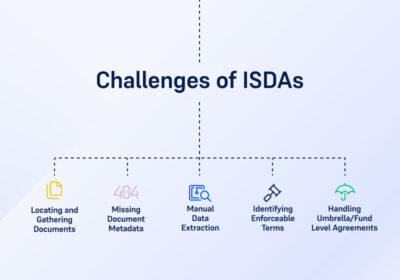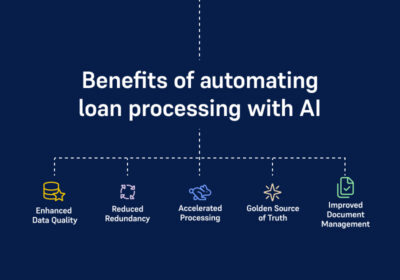Straight-through processing: Integrating Document AI for maximum efficiency
For use cases such as compliance or regulatory reporting that require total precision, Document AI can achieve up to 100% accuracy when machine learning techniques are combined with human review. But, for use cases where a small number of errors can be tolerated or stringent quality control and model risk management protocols are built-in, human review can be reduced or even eliminated to complete the task even faster and cheaper. This is known as straight-through processing (STP).
The origin of straight-through processing
STP methodologies were initially developed to automate electronic payment transfers, reducing the need for manual intervention and making them virtually instantaneous. Before STP, sending money involved multiple departments, both on the initiation and receiving end of the transfer, and took days to complete. The old process required data to be rekeyed and rechecked, which was time-consuming, prone to error and made transactions more susceptible to fraud. With the advent of STP, the entire process was automated, eliminating the duplication of effort, reducing the risk of errors and fraud, accelerating the turnaround time and lowering the processing costs.
STP development started in the early 1970s when the banking industry first began integrating computers and computer programming into their daily operations, significantly upgraded banking payment transfers from a much slower, less secure telegraphic system. Beyond payments, STP has revolutionized securities trading by automating and digitizing previously complex and cumbersome manual trade settlement processes. Before STP, to settle a trade, phone calls, emails and paperwork needed to be exchanged between the buy and sell-side. The information would be re-entered and cross-checked, and the trade wasn’t complete until receipt of the certificate and payment were confirmed by both parties. Following the old manual process, it would take up to 10 days to settle a trade whereas STP reduces the average to just 2-3 days.
STP has many uses and can be applied to any transaction, settlement process or financial product to eliminate the bottlenecks and costs inherent in human-led processing. Many banks and financial service providers use STP across multiple processes and functions to achieve paperless offices.
The role of Document AI in straight-through processing
At the heart of STP is the near real-time transferral of information between systems and parties, using technology as the enabler. STP is now the norm for payments, but it’s also been applied more broadly to repetitive processes that are transactional and can be automated to drive efficiencies. For example, Document AI can remove the need to manually review new loan agreements and extract the salient information required to complete the deal and feed internal systems to help manage the loan over its entire lifetime. This eliminates inefficient manual processes and the risk of human error.
STP is beneficial for automating steps in long processes where information would otherwise be rekeyed between systems to be used by multiple teams. Document AI can meet different functional teams' information requirements and gather insights and transform data to eliminate steps in various processes. Wherever you have sets of documents that are subject to periodic review, require some form of follow-up processing or where events can trigger the need to dive into individual contracts, Document AI can help. Using a technique called point extraction, the technology pinpoints and extracts the exact word, number, phrase or sentence that each user or team in the process might need in the future. This technique outputs precise results that can be used as-is or can form the basis for further analysis that the platform can be trained to perform automatically. By applying logic, Document AI can interpret the extracted data and provide actionable insights and answers to complex questions.
Analyzing documents manually is time-consuming and expensive, especially for organizations with large volumes of documents to review regularly. Ultimately, the goal of STP is to make end-to-end operations less dependent on human intervention and speed up processing times. Document AI can play an integral role in the straight-through processing of documents. By extracting and compiling the necessary data and sending it to other systems, the human effort required in processing your documents is minimal.
The benefits of straight-through processing your documents
Document AI makes it possible to automate document analysis with rapid and precise results, so your people don’t have to scour them repeatedly. The Eigen platform can extract dozens of key terms from hundreds or thousands of documents creating significant efficiency and reducing processing time and costs. It can automate processes to smooth the transfer of data associated with document analysis, data entry, cross-checking and eliminate the need for multiple approval steps. As a result, clients report a range of benefits including closing deals faster to bring in revenue sooner, saving on outsourcing costs, enabling teams to focus on higher-value work and the ability to make better more timely decisions and action requests faster.
To achieve maximum efficiency, you should identify every touchpoint over the document's lifespan, including all upstream and downstream users, systems and processes. Once you’ve identified all the touchpoints, you can gather requirements from all impacted parties and factor their needs into the data flow to ensure you achieve the highest possible level of automation. Where data formats are inconsistent across systems and information would usually be rekeyed, we’ve developed customized plugins to transform it before its send to other systems via APIs. For example, date formats can be located and automatically reconfigured for international transactions (e.g., changing the date format from the US to UK standard).
The diagram below illustrates how Document AI integrates with other systems within an organization.

The Document AI future is now
Thanks to STP methodologies and Document AI, entire processes can be automated, and the extracted data can be integrated seamlessly with internal systems. This enables documents to be processed with little-to-no human intervention. In addition, clients that use Eigen for STP purposes have full visibility of the documents being processed and the data being extracted so they can review and audit the results at any time. They remain in total control even when the machine is doing all the work.
Gathering, analyzing and manually rekeying data to process documents is both ineffective and expensive. Using Document AI, you can empower your team to spend more time on tactical, revenue-generating tasks and less time on time-consuming manual review procedures. STP holds the key to achieving maximum efficiency, and you can harness its power through Document AI for your information management needs.
In our next blog, we’ll look at how you can apply Document AI technology across your enterprise.
Wondering how Document AI can save your organization time and money? Request a demo of our platform to find out how.
-
World Economic forum 2020
-
Gartner Cool Vendor 2020
-
AI 100 2021
-
Lazard T100
-
FT Intelligent Business 2019
-
FT Intelligent Business 2020
-
CogX Awards 2019
-
CogX Awards 2021
-
Ai BreakThrough Award 2022
-
CogX Awards Best AI Product in Insurance
-
FStech 2023 awards shortlisted
-
ISO27001
-
ISO22301
-
ISO27701
-
ISO27017
-
ISO27018


















